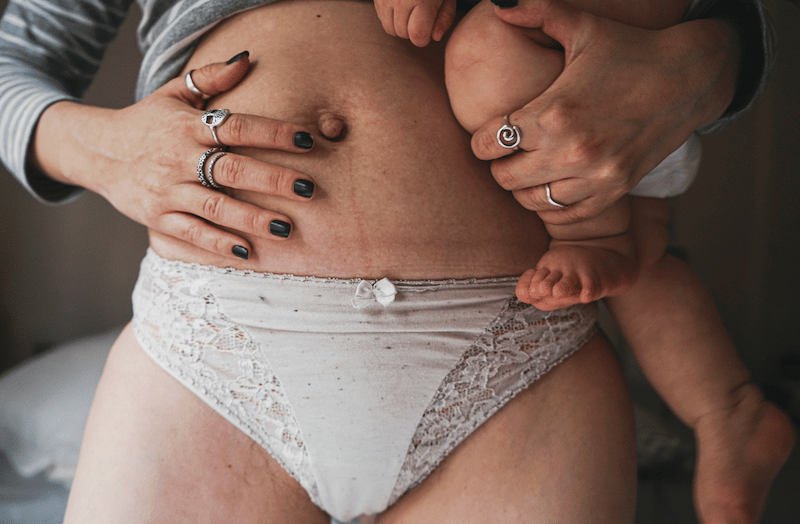
The Postpartum You: What To Expect After Delivery
The postpartum time period can often be a gray area. While all of the focus and attention shifts to the baby, it can be easy to forget that your body just went through a traumatic experience and you are now entering a new phase of life, with all of the emotions and uncertainties that go with that. At Diana Health, we feel that it’s important that every woman feel prepared and empowered moving into the postpartum experience, so we’re giving you the goods and breaking down what to expect from your body and emotions after having your baby. Being prepared is the best way to smooth the transition and make the beginning of your new life together a little less painful (literally and figuratively.) The information may apply more to women who have had a vaginal delivery, or who labored and pushed prior to having a cesarean, but more specific information about cesarean delivery recovery is included near the bottom of this document.
Vaginal Soreness
It’s normal for your vaginal area to be sore after delivery, especially if you had an episiotomy or vaginal/vulvar tear. Follow the instructions that your CNM/OB gave you for caring for this sensitive area, which may include rinsing with warm water (consider using a squirt bottle) and being extra gentle when wiping. You’ll want to keep this area clean, while avoiding any harsh soaps or cleansers.
Additional treatment options include:
- Peri bottles
- Witch hazel pads
- Benzocaine spray
You may get some extra relief by layering these treatments. For instance, you can wear the hospital mesh underwear, layered with a pad, an ice pad, and three witch hazel pads in a line, and then spray that with benzocaine.
GOING #1 AND #2
Urinating soon after delivery can be uncomfortable due to the trauma that your vagina and surrounding areas just experienced. If you have burning during urination or feel like you need to urinate urgently, notify your practitioner as this could be a sign of a urinary tract infection. If your skin stings when you urinate, consider spraying where urine comes out with a water bottle which can help this tender skin while it is healing.
Having a bowel movement soon after delivery can also be uncomfortable, especially if you tore near the rectum or between the vagina and rectum. Don’t strain to defecate and don’t try to avoid having a bowel movement when you have to go. Try to avoid constipation by:
- Drinking enough water
- Taking stool softeners (if recommended by your health practitioner)
- Eating a healthy diet rich in fiber
VAGINAL DISCHARGE
Vaginal bleeding/lochia is normal after you have a baby and may last for a few weeks. It may be red, brown, or pink. The colors often change as the healing progresses, starting with the darkish red in the first 3-4 days, then moving to pinkish brown on days 4-10 and whitish yellow from 10-28 days. It should decrease in amount as time goes by. If you experience heavy bleeding or malodorous vaginal discharge, notify your health care practitioner.
Most women wear pads for several weeks after delivery to stay clean. Please avoid tampons at this time, as their use increases the risk for infection postpartum. Consider purchasing pads in advance to have at home when you return from the hospital. You may want to buy softer, overnight cotton pads that are extra gentle for that sensitive area and avoid pads with any fragrances or dyes.
WHAT UNDERWEAR TO WEAR?
Using special, disposable mesh underwear provided by the hospital is normal for the first few days after you have a baby. Most women are not able to wear their pre-baby underwear for some time after delivery and wearing the disposable stretchy underwear saves you from having to clean your underwear if they get blood on them. You may want to make a change to women’s discreet diapers after the first couple of days. You can also use comfortable high waisted postpartum underwear with overnight pads.
CHANGES TO YOUR BREASTS
Your breasts will become larger and feel fuller as your milk supply comes in over the first few days. Engorgement happens when the milk is not emptied from the breasts. If you are breastfeeding, work closely with your lactation consultant to ensure that your breastfeeding posture supports your back and neck health, that your baby is latching on and getting an adequate amount of milk, and that your nipples and breasts are healthy as you learn to breastfeed. Your nipples may get blistered, raw and sore due to breastfeeding. Lactation consultants can help tremendously. They are experts and they love working with breastfeeding women and their babies. Use their expertise whenever you can. Your nipples will likely leak between nursing sessions, especially early on. You can use a nipple balm or coconut oil before and after each feeding session, or you can request APNO cream. There are also special pads that go inside nursing bras to prevent wet spots on your shirts. If you are a first time nursing mother, consider taking the Diana Health lactation class for more information. Especially for women without access to a lactation consultant, the Women Infant and Children (WIC) website as well as La Leche League are wonderful sources of information.
CONTRACTIONS EVEN AFTER BIRTH
Your abdomen does not immediately return to its pre-baby state after you deliver your baby, it takes several weeks for the process. After delivery, the top of your uterus is about at the level of your belly button. Over the next few weeks, your uterus will continue to contract and return to a small size, similar to its pre-pregnancy size. This uterine cramping is normal. Your abdomen will therefore be larger than it was prior to getting pregnant. Don’t expect to fit into your pre-pregnancy clothes when you are leaving the hospital. Bring some yoga pants or stretchy comfortable clothes that you can wear.
EMBRACE YOUR NEW BODY
The rest of your body also takes time to return to its pre-pregnancy state. During pregnancy you may have developed stretch marks, hemorrhoids, your breasts likely enlarged, and you likely gained weight. Over time, your body will become closer to how it was prior to pregnancy. However, some changes may be permanent. Be gentle with yourself and remember that you just delivered a baby from your body, which is an amazing accomplishment for any woman! Your value is not determined by your appearance. Be patient with yourself; love yourself and your body.
WHAT ABOUT IF I HAD A C-SECTION?
If you’ve had a cesarean section or an operative vaginal delivery (forceps or vacuum delivery), your CNM/OB will give you special instructions when they discharge you. These instructions will help to support your body’s healing process after these procedures. Be patient with yourself. The healing process will be longer. Don’t compare yourself to your best friend or next door neighbor that just had their 6th baby and only pushed once.
WHEN SOMETHING’S NOT RIGHT
Here are some warning signs to watch out for. If you experience any of these, we want to see you and treat you as soon as possible.
• If you develop a fever
• If your vaginal discharge becomes malodorous
• If you start having vaginal bleeding that is heavy or increasing
• If your vagina/vulva/perineum (area between the vagina and rectum) become painful
• If your abdomen or pelvis become painful
• If your cesarean section scar becomes painful or red
• If you have a headache that does not quickly resolve
• If you experience change in vision, shortness of breath, chest pain, calf pain or swelling
• If you have pain or difficulty urinating, problems with having a bowel movement
• If you have redness of any area on your breasts, breast pain, cracked nipples
For these or any other concerns, problems, or questions, reach out to your Diana Health provider via the Diana Health app or, book a visit to see us. The Postpartum experience can be overwhelming, but you’re not in it alone! We are here for any needs you may have.
Share This Post



























